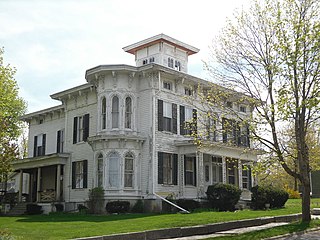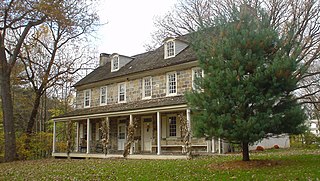
Roudebush Farm is a historic farmstead located southeast of Harrison in northwestern Hamilton County, Ohio, United States. It was established in the 1850s with the construction of a small frame residence. This building, the original farmhouse, was built just one story tall and composed of two rooms. The builder was the farm's namesake, Hammand Hersh Roudebush.

The John Brown Farm State Historic Site includes the home and final resting place of abolitionist John Brown (1800-1859). It is located on John Brown Road in North Elba near Lake Placid, New York, where John Brown moved in 1849 to lead freed slaves in farming. It was declared a National Historic Landmark in 1998. It has been managed by the state since 1896; the grounds are open to the public on a year-round basis, and tours of the house are offered in the warmer months.

Palatine German Frame House is a historic home located at Herkimer in Herkimer County, New York. It is a 1 1⁄2-story, rectangular, gable-roofed, heavy timber-frame building, five bays wide and two bays deep. It measures approximately 39 feet by 23 feet. It was built after the middle of the 18th century.

The McClelland Homestead is a historic farm in western Lawrence County, Pennsylvania, United States. Located along McClelland Road northeast of Bessemer, the farm complex includes buildings constructed in the middle of the 19th century. It has been designated a historic site because of its well-preserved architecture.

The Terwilliger–Smith Farm is located on Cherrytown Road near the hamlet of Kerhonkson in the Town of Rochester in Ulster County, New York, United States. It was established in the mid-19th century.

Home Farm, also known as the Mirriam-Bartholomew House, is a historic home and farm complex located at East Whitehall in Washington County, New York. The house was built about 1840 and consists of a two-story, five bay, center entrance brick main block with a rear brick kitchen wing in the Greek Revival style. The farm complex has 17 contributing resources including a frame cow barn complex, a timber frame horse and carriage barn, a light frame creamery, a light-frame sugar house, and a brick smoke house.
Town–Hollister Farm is a historic home and farm complex located at North Granville in Washington County, New York. The house was built about 1810 and consists of a 2-story, center entrance main block with a 1 1⁄2-story kitchen ell. The property also includes a mid-19th-century turnpike marker, timber-frame barn, car garage, well, cow barn, machinery shed, corn crib, barn cluster, hay barn, and windmill.

Hand–Hale Historic District is a national historic district located at Elizabethtown in Essex County, New York. The district contains seven contributing buildings. It encompasses the Hand House and Law Office, the Hale House and Law Office, and dependencies associated with both properties.

Bragdon-Lipe House is a historic home located at Canajoharie in Montgomery County, New York. It was built about 1860 and is a two-story, timber frame vernacular Italianate style residence. The main block is nearly square and has a two-story kitchen and service wing in the rear. It features an ornate two-story, polygonal wall bay and an enclosed square belevedere at the center of the roof. Also on the property is a carriage barn dated to about 1870.

Glen Historic District is a national historic district located at Glen in Montgomery County, New York. It includes 52 contributing buildings and two contributing sites. The district encompasses the historic core of a rural crossroads hamlet. The majority of the structures are one and one half or two story, timber framed buildings with gable roofs. At the crossroads are the most distinguished buildings: two large Federal style residences, a mid-19th century general store, and a distinguished, Second Empire style brick residence built in 1878.

Teunis Houghtaling House, also known as Vredehuis, is a historic home located at Clarksville in Albany County, New York. It was built in two stages: the 1 1⁄2-story main block was built about 1770, expanded to a five-bay dwelling about 1790, at which time a 1-story addition was also completed. It is constructed of hand-hewn timber framing. Also on the property are two frame outbuildings and a small family cemetery with burials dating to the early 19th century.

Windswept Farm is a historic home located at Clinton in Dutchess County, New York. The main block of the house was built about 1823 and is a Federal-style dwelling. The main block is a 2-story, five-bay timber-frame house. A 1 1⁄2-story gabled addition was completed about 1840. Also on the property are two barns and a cider mill.

Clifton Park Hotel is a historic hotel located at Clifton Park and Halfmoon in Saratoga County, New York. It was first erected in the 1820s and is a 2-story, timber-framed building sheathed in clapboards and topped by a gable roof. A massive, 2-story wood portico / piazza was added in the 1840s, along with a 1 1⁄2-story, two-bay, frame addition. The building was renovated in the 1880s and once featured a dance hall. The building exhibits a number of Greek Revival design features. It remained in commercial use into the 1970s.

Grooms Tavern Complex is a historic tavern located at Grooms Corners in Saratoga County, New York. The complex consists of the tavern, a wagon and blacksmith shop, and a frame privy. The tavern building was built about 1825 and is a 2-story, timber-framed, gable-roofed building in a vernacular Federal style. It consists of a main block with 1 1⁄2-story, frame kitchen wing in the rear. When expanded to two stories in the 1840s, a Greek Revival style cornice was added. The building was partially remodeled in the late 19th and early 20th centuries. The tavern building was also operated as a general store. The wagon and blacksmith shop was constructed in the 1840s and is a 2-story, rectangular, timber-framed building with a gable roof in the Greek Revival style.

The Elisha Purington House also known as Pride Farm, is an historic house at 71 Mast Road in Falmouth, Maine. Built in 1761, it is a rare surviving example of Georgian architecture in Maine's rural interior. It was listed on the National Register of Historic Places on February 14, 1985.

Collen Brook Farm, also known as Collenbrook, is a historic home and associated buildings located at Upper Darby Township, Delaware County, Pennsylvania. The complex includes three contributing buildings: a farmhouse, a granite spring house, and stone and frame carriage house. The house is a 2 1⁄2-story, vernacular stone residence with a Georgian plan and consisting of three sections. The oldest section was built around 1700, with additions made in 1774, and 1794. It was the home of noted educator and political leader George Smith (1804–1882).

The Burt–Cheney Farm is a historic farmstead on U.S. Route 302 in Bethlehem, New Hampshire. The main farm house, built in part about 1818, is a rare early Cape-style house, and is one of the oldest surviving buildings in the town. The property was listed on the National Register of Historic Places in 1982.

The Smith House is a historic house on Memphis Street in Wheatley, Arkansas. It is a 2-1/2 story wood frame structure, designed by Charles L. Thompson and built in 1919. It is the most architecturally significant building in the small community, exhibiting Craftsman style elements including exposed rafters, large brackets supporting extended eaves, and half-timbering on its gable ends. The rural setting, on a farm, is also unusual for Thompson's work, which is usually found in residential areas.

The David Hanaford Farmstead is a historic farm in Monticello Township, Minnesota, United States. It was first settled in 1855 and features a farmhouse built in 1870 and a barn from around the same time. The farmstead was listed on the National Register of Historic Places in 1979 for having local significance in the themes of agriculture and exploration/settlement. It was nominated for being "an excellent example of an early Wright County farmstead developed by a pioneer family from New England."

The Heights, also known as the Thaddeus Chapman House is a historic country estate on Vermont Route 30 in Middlebury, Vermont. Developed in the 1870s and 1880s, the property is one of the finest estates of the period in the state. It was listed on the National Register of Historic Places in 1988.
























